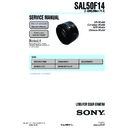Sony SAL50F14 Service Manual ▷ View online
4-6
SAL50F14 (1.4/50) (50mm F1.4)
4)
Click the calculate button to measure the image.
5)
After measuring, check the “G” values.
Average “G” value of the three images shoot with master lens:
(a)
Average “G” value of the three images shoot with checking lens: (b)
Fig.4-2-8
3. Checking Method
1)
Calculate aperture error using the following formula, and check that the aperture error is within the specification.
Aperture error = Average “G” value of checking lens (b) - Average “G” value of master lens (a)
Specification
Aperture error = 0
±12
2)
When the aperture error is out of specification, perform “4-2-2. Aperture Diameter Adjustment”.
Calculate button
Check the “G” value
Ver. 1.2 2008.01
The changed portions from
Ver. 1.1 are shown in blue.
Ver. 1.1 are shown in blue.
4-7
SAL50F14 (1.4/50) (50mm F1.4)
4-2-2. Aperture Diameter Adjustment
Equipment
• Luminance Box
• Camera DSLR-A100
• AE Master Lens
• Compact Flash (CF) Card (For image saving)
• Personal Computer (PC)
(Color Calculator 2 installed)
• Adhesive bond (B-10)
• Name Ring Wrench (55mm)
1. Adjustment Method
1)
Disassemble or assemble the checking lens into the state of Fig.4-2-9.
Fig.4-2-9
2)
Remove the adhesive bond fixing the aperture unit holding spring.
Fig.4-2-10
Front Ball Lens Block
Adhesive
Bond
Bond
Aperture Unit Holding Spring
Adhesive Bond
4-8
SAL50F14 (1.4/50) (50mm F1.4)
3)
Move the preset lever to set the preset ring at the open aperture position.
Fig.4-2-11
4)
Turn the apreture unit holding ring to adjust the position that the diaphragm blades are hidden into the edge completely.
Fig.4-2-12
5)
After the adjustment is completed, apply the adhesive bond (B-10) as shown in the Fig.4-2-13.
Fig.4-2-13
6)
Assemble the lens completely.
7)
Perform “4-2-1. Aperture Diameter Check”, and repeat “4-2-1. Aperture Diameter Check” and “4-2-2. Aperture Diameter Adjust-
ment” until the aperture error is within the specification.
Set the Preset ring at the open aperture position.
Preset Lever
Iris feather unit are hidden into the
edge completely.
edge completely.
Aperture Unit Holding Ring
Adhesive
Bond
Bond
Aperture Unit Holding Spring
Adhesive Bond
4-9
SAL50F14 (1.4/50) (50mm F1.4)
4-3.
PROJECTIVE RESOLVING POWER CHECK
Equipment
• Lens Test Projector and Variable Transformer (Output voltage: AC 100 V)
Note:
Connect the variable transformer (Output voltage: AC 100 V) to the lens test projector.
• A-mount Attachment
• Screen (Art paper)
• Tape Measure
• Plane Mirror (For SLRs)
• Name Ring Wrench (55mm)
• Universal Wrench
• Chip-A for Universal Wrench
• Chip-B for Universal Wrench
1. Preparations
Note:
Note:
Check the projective resolving power of the checking lens at the following focal-length and distance.
Focal-length f (mm)
distance (m)
50
0.9 to 2.17
Table 4-3-1
1)
Perform the following steps (1) to (3), and incorporate the internal lenses of the lens test projector according to the checking focal-
length.
(1) Open the lid of the lens test projector.
(2) Pull up and turn the fixed levers on the right and left sides of the lens test projector.
(3) Remove or insert the lens.
Note:
Be sure to have the right position and direction of the lens.
Fig.4-3-1
Lens test projector
Incorporate of the lenses
according to the checking focal-length (f).
according to the checking focal-length (f).
Lens
Fixed lever
Fixed lever
Lid
f=18 to 35 mm
f=35 to 100 mm
f=100 to 200 mm
f=200 to 300 mm
Heat-absorbing filter
Chart
Chart
Chart
Chart
Filament
Filament
Filament
Filament
Click on the first or last page to see other SAL50F14 service manuals if exist.

